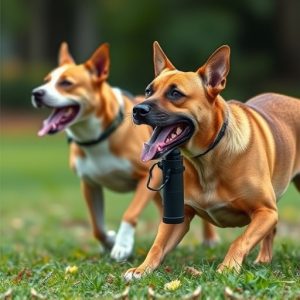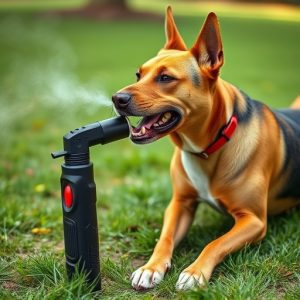Prevent Dog Attacks: Mastering Pepper Spray Safety & Application
Understanding canine behavior cues is vital for predicting dog actions and maintaining a safe distan…….
Understanding canine behavior cues is vital for predicting dog actions and maintaining a safe distance of 3-4 feet during interactions. When choosing dog attack prevention pepper spray, consider formulations designed specifically for canines, ease of use, and legal constraints in your area. Effective application techniques include aiming for the eyes and face from 18-24 inches away, while adhering to local regulations regarding safe spraying distances and restrictions in public spaces. Always prioritize safety through protective gear, proper ventilation, secure storage, and training to ensure responsible and effective use of pepper spray as a last resort against aggressive dogs.
“Dog attacks can be terrifying experiences, but taking preventive measures can significantly enhance safety. In this article, we explore an innovative solution: dog attack prevention pepper spray. Understanding canine behavior is crucial for effective deployment, especially when determining the safe spraying distance for dogs. We guide you through choosing the right pepper spray, mastering application techniques, and adhering to legal considerations. By the end, readers will be equipped with vital knowledge to protect themselves during potential encounters.”
- Understanding Dog Behavior: Key to Safe Spraying Distance
- Choosing the Right Pepper Spray for Dog Attacks
- Effective Application Techniques and Safety Measures
- Legal Considerations and Responsible Use of Pepper Spray
Understanding Dog Behavior: Key to Safe Spraying Distance
Understanding a dog’s behavior is crucial when considering the safe spraying distance for dogs to prevent attacks. Dogs communicate through body language and vocal cues, which can signal aggression or fear. By observing a dog’s posture—a raised tail, fur along the back, or bared teeth—you can anticipate its actions. These behaviors often precede an attack, providing a critical window of opportunity to maintain a safe spraying distance. Knowing when to use pepper spray requires understanding these signals and responding appropriately to ensure your safety without causing unnecessary harm.
Choosing the Right Pepper Spray for Dog Attacks
When selecting a pepper spray for dog attack prevention, it’s crucial to consider factors like safe spraying distance and canine-specific formulation. The Safe Spraying Distance for Dogs is typically around 3 to 4 feet (approximately 1 to 1.2 meters), ensuring you can apply the spray effectively without risking harm to yourself or others nearby. Look for sprays designed specifically for dog encounters, as these will have a strong enough kick to deter an attacker but be formulated to minimize injury to both dog and handler.
Choose products with non-irritating components and low chemical load, which can help reduce the risk of adverse reactions in dogs, especially if the animal is already stressed or injured. Additionally, consider factors like spray pattern, range, and ease of use, ensuring the sprayer is comfortable to hold and provides a consistent stream under pressure. Regular training with the chosen pepper spray is essential to ensure its safe and effective deployment during an actual attack.
Effective Application Techniques and Safety Measures
When using dog attack prevention pepper spray, understanding effective application techniques is crucial. Aim for the eyes and face, as this area is highly sensitive in dogs, similar to humans. Hold the can 18-24 inches (45-60 cm) away from the target animal, aiming slightly above eye level. This safe spraying distance ensures maximum effectiveness while minimizing potential collateral damage or harm to bystanders. Capping the can and shaking it vigorously before each use is essential to mix the active ingredients evenly, guaranteeing potent spray distribution.
Safety measures are paramount when handling pepper spray. Always wear protective gear, including gloves and eye protection, to avoid direct contact with the spray. Ensure proper ventilation in the area to prevent inhalation of irritants by yourself or others present. Keep the spray out of reach of children and pets, storing it in a secure location. Familiarize yourself with local regulations regarding pepper spray use, as there may be restrictions on where and how it can be employed, especially in public spaces.
Legal Considerations and Responsible Use of Pepper Spray
When considering dog attack prevention pepper spray, it’s crucial to understand legal considerations and responsible use. Each jurisdiction has its own laws governing the possession and use of pepper spray, so it’s essential to research and comply with local regulations before purchasing or carrying such a device. Using pepper spray on an aggressive dog should be a last resort, and it’s critical to deploy it safely—maintaining a safe spraying distance for dogs, typically around 2-3 feet, to minimize risk of injury to the animal while effectively deterring an attack.
Responsible use involves ensuring that you have a clear understanding of how the spray works, its range, and its effects. It’s also important to keep pepper spray out of reach of children and pets, store it securely, and only use it when absolutely necessary for self-defense against an imminent dog attack. Regular training and familiarization with the device can help ensure that you react calmly and accurately under stress.
Preventing dog attacks with pepper spray can be an effective strategy, but understanding dog behavior and choosing the right product are key. By maintaining a safe spraying distance and adhering to legal guidelines, individuals can protect themselves while minimizing harm to animals. Responsible use of pepper spray, combined with knowledge about canine instincts, offers a powerful tool for ensuring safety in potential attack scenarios.


